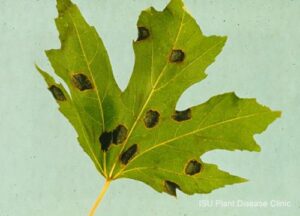Characteristics of tar spot
Maple tar spot is a common fungal disease caused by three related fungi in the genus Rhytisma. The symptoms may vary slightly depending on the strain of the fungus but all three fungi produce dark, slightly raised spots on maple leaves that resemble drops of tar by late summer. These fungal spots actually start to develop in late spring or early summer but as they are smaller, light green dots that blend in with the leaves, they are not as detectable early in the season.
One of the three fungal strains (Rhytisma americanum) infects our native maples: its main hosts are sugar maples, silver maples, red maples and the hybrid of silver and red maples, the Freeman maple. However, the maple tar spots that are most evident in the Toronto area in late summer are found on Norway maples, a non-native tree planted widely as a street tree across the city. Norway maples have a different fungal agent, the imported pathogen Rhytisma acerinum.
Although unsightly, tar spot does not usually affect the health of the tree, although it may cause early leaf drop due to stress if the tree is badly infected. In most cases, the trees are still capable of carrying out photosynthesis throughout the growing season, energy reserves have been returned to the roots and next year’s buds produced, allowing the tree to leaf out normally the following spring.

Tar spot on maple
Source: https://hortnews.extension.iastate.edu/maple-tar-spot
How the disease spreads and survives
The fungus overwinters in the black, tarry spots on the fallen leaves. The spores are released in the spring and carried by wind and water to their host plant. The timing of their emergence coincides with the flush of new leaves on the host trees and can continue into early summer as the leaves expand. Wet weather encourages the rate of infection.
Cultural control
There are two schools of thought regarding control of tar spot of maple. One is that all the fallen leaves should be raked up and sent to the city for composting to destroy the pathogen and interrupt the life cycle of the disease. Most university extension departments advocate this approach.
Another approach is to keep the leaves on your property where at least they have value as mulch, return nutrients to the soil and serve as habitat for overwintering insects. Since the disease is so widespread, particularly on invasive Norway maples, now found in ravines and other public areas in Toronto, it is unlikely that the fungus could ever be completely eliminated or controlled. (See management of tar spot: Morton arboretum and University of Guelph arboretum.)
If you do decide to compost the leaves on your property, the compost pile should be covered or turned in spring to prevent the fungal spores from infecting newly emerging maple leaves. This may help reduce the infection for the following year but will not eliminate the disease completely, as most home compost piles are rarely hot enough to kill all the pathogens.
Resources
Leave your leaves this fall. Yourleaf.org blog, September, 2019.
Hsiang, Tom, et al. Tar spot of maple: where did it come form and is it getting worse? Department of Environmental Biology, University of Guelph, 2008.
The Morton Arboretum. Tar spot of maple.
Cornell University, College of Agriculture and Life Sciences. Tar spot of maple: Rhytisma spp. 2015
Iowa State University Extension and Outreach. Maple tar spot. 2022.
Maine Forest Service, Department of Agriculture, Conservation and Forestry. Tar leaf spot of Norway Maple, Rhytisma acerinum. 2013.

